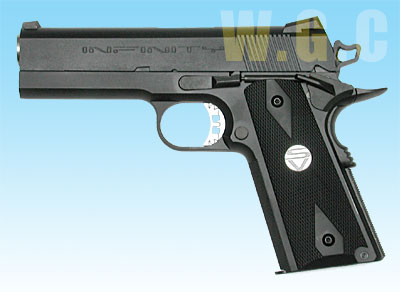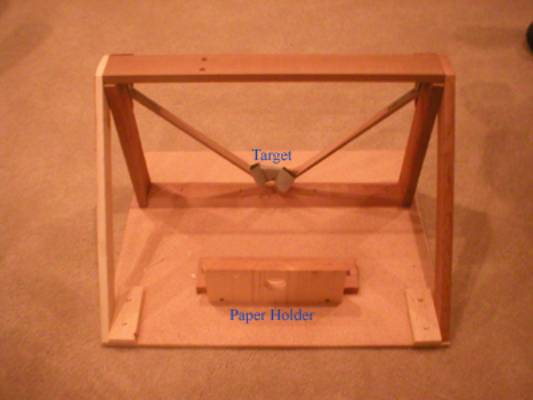







|
2. Procedure 3. Results 4.Analysis 5. Possible Errors 6. Work log 7. Bibliography |
|
Question: How is the velocity of a .2 gram projectile (bb) affected by passing through sheets of paper? Hypothesis: We believe that the velocity of the bb will decrease with each added sheet of paper. |
|
Procedure: In order to conduct the experiment we needed an apparatus to shoot the bb and an apparatus to shoot and measure the speed of the bb with.
 THIS IS NOT A REAL GUN The piece of equipment we used for this experiment to shoot the bb was an Airsoft gun. The gun uses green gas at 70 PSI (480,000 N/M) to propel .2 gram plastic bbís.The particular gun we used was a Western Arms 1911 5.0 IED with a 140 mm long barrel.
 We shot the target with the Airsoft gun from the paper holder and measured the distance that the target swung in centimeters. The tape combined with modeling clay would catch and hold the bb in place to conserve energy. Using the weight of the target, the weight of the bb and the height of the target, we calculated the final velocity of the bb using the following formula: V = ((m + M)/m)(sqr(2g(sqr(((x^2)/(L^2)-L)
M= Target weight
Below are measurements of the apparatus and involved measurements: |
|
Results: Distance of swing of the target in CM
 
Final velocity in meters per second   For a text version of all data, go to the data page. |
|
Analysis: As the graph shows, there is a decline in velocity as more sheets of paper are added. The decline is not as steep as we had anticipated, but there is a definite decrease in velocity. Our final speed measurement with no sheets of paper blocking the projectile averaged 101 meters per second. This is very close to the data we received from an electric chronograph, which read 315 feet per second or 96 meters per second, so we are very pleased with the outcome of our own test and trust that results we received from the trials with paper are consistent and relatively free of error. |
|
Possible Errors / Sources of Uncertainty: We had anticipated that the friction from the hinges where the target was attached would cause a problem in the final velocities we received, however, since the swing arms were so light it didnít seem to pose a problem. We also assumed that since we had to measure the distance the swing arm traveled only by eying it that we would get some numbers that werenít consistent. It appears that we have several data points that were inconsistent with the rest of the data, but on the whole, this was not a large issue either. At one point, we tried to remedy this problem by filming the experiment and taking screen shots at the apex of the swing arms travel, however the camera we used did not have a high enough frame rate to capture the apex or give a clear image of where it was. |
|
Work Log: December 12, 2003: Six hours spent building and testing several prototype apparatuses. No valuable data was taken, as none of the structures we built succeeded at taking useful data. January 8, 2004: Three and a half hours spent building and testing final apparatus. January 12, 2004: Two hours spent taking data. |
|
Bibliography: Paul Lopansri. Pick Your Poison. Classic Airsoft http://www.classicairsoft.net/Gas/gas.htm
Wargame Club Shop. www.wgcshop.com |
|
By Alex Najdek, David Pucknell and Sean Mann Back to Research home. |